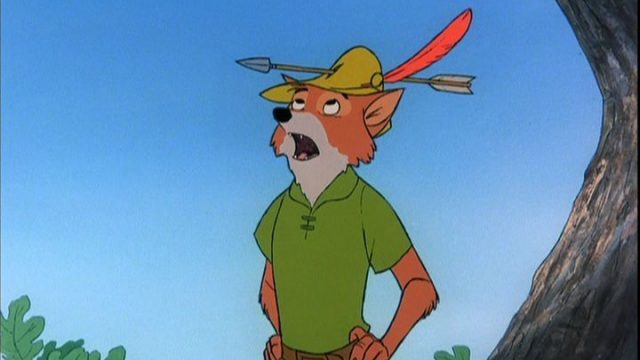It wasn’t that Walt didn’t think the tale of Reynard the Fox couldn’t make money. Not really. It’s that he didn’t see how Reynard could be a hero, and their format didn’t really allow for a generic trickster character. I suppose it would work now, with Disney’s shift in focus, but forty-odd years ago? Forget it. Robin Hood, however, maintained some of the trickster elements while still being thought of as a hero. So there we are.
Robin Hood (Brian Bedford) and Little John (Phil Harris), walkin’ through the forest, et cetera. It is Nottingham and Sherwood Forest and all that, during the regency of Prince John (Peter Ustinov). The poor are taxed to death, and Robin and Little John see it as their duty to take back some of that tax money and distribute it to the poor. Prince John is none too thrilled about this, and the Sheriff of Nottingham (Pat Buttram) is under strict orders to bring Robin in. Meanwhile, Robin is pining over the fair Maid Marian (Monica Evans), who is pining over him just as hard. Really, no part of this story is a surprise to anyone with the slightest knowledge of English folk tales.
I mean, except the “everyone is an animal” part, I grant you. Robin, and probably Marian as well, introduced many a person of my generation to the idea of furrydom. It wouldn’t surprise me, though you’ll understand I’m not going to look this up, to discover that there’s more fan art of them than any other anthropomorphized characters in the animated canon. Even those of us who aren’t furries can acknowledge that Robin and Marian are quite attractive, in the “anthropomorphized animal” department. They also have a genuine love that goes beyond most of the Disney love-at-first-sight variety.
You see, we already know that Robin and Marian have cared about each other for many years at the point at which the story starts. Sure, they haven’t seen much of each other of late, but it’s still more than most Disney romances get. They were children together. While that doesn’t always lead to romance, I do have two different sets of friends who have been with their high school sweethearts. It happens, and it wouldn’t surprise me to know that sort of relationship is more lasting than people who marry all at once in the height of passion.
This movie is an interesting companion piece with The Lion in Winter. Eleanor of Aquitaine never actually appears in this film, but she’s hinted at—Prince John has mommy issues. In fact, IMDb points out that he doesn’t have a mane, which makes him female, but that’s not the reason. The reason is obviously that he is a child. It’s not just that Richard was nine years older than John; that hardly matters. What matters is that John is immature; he isn’t ready to be king, because he’s too interested in his own pleasures.
That Richard wasn’t any better is irrelevant; the problem with putting historical context into a Robin Hood story is that, frankly, the Robin Hood story has been full of bad history for centuries. Prince and later King John was more interested in taxing the wealthy than the poor, presumably because you could get more money out of the wealthy—especially in the days of serfs, when the poor had even less money than they do now. Practically the only historical inaccuracy the movie adds is “too late to be known as John the First,” since this John remains the only English King John. Still, it rhymes, which is the point.
By mid-seventies Disney music standards, this movie has some fine music. “Love,” its Oscar-nominated song, lost to “The Way We Were.” And, yes, “Whistle-Stop” is irrevocably tied to “Hampster Dance.” Fair enough. Still, the music is more than passable, and it’s one of those movies where characters’ singing sometimes makes sense in context—our narrator, Alan-a-Dale (Roger Miller, one of the film’s songwriters), is a minstrel, after all. And, yes, the various characters sing a song because singing new, catchy songs is a thing that happens.
Look, let’s talk about the borrowed animation. Apparently, this is in no small part because of changes that meant the film wasn’t up to its release schedule, so corners were cut. But to hear some people talk, you’d think a lot more animation was borrowed than actually was; it’s a single musical number that has some borrowed dancing, not the whole thing. And the climax in the burning castle is really quite well done for the era, which is in the awkward phase between Walt’s death and the studio’s finding its footing again.
Another Soluter refers to this as my generation’s Space Jam, and I dispute the title. For one thing, it’s far less cynical a cash-grab. For another, there is something to be found here even if you don’t remember 1974, which I assuredly do not, not having been born until 1976. It’s not Disney’s greatest animated film by any stretch—we’ve already talked about better movies and haven’t even gotten to Fantasia—but it’s certainly better than many others. (Has anyone actually seen Home on the Range?) And while the movie isn’t completely a traditional take on the legends, few versions are, and there’s more room to play. There is no Lola Bunny equivalent here.
Also, there is one of my favourite lines in any Disney movie, animated or live action—Little John’s “Who’s driving this flying umbrella?” There’s the children. The surly badger Friar Tuck (Andy Devine). Lady Kluck (Carole Shelley), the feisty Scottish chicken. The wry humour. There’s a lot to discover in this movie. I like it, and not just for nostalgia’s sake. Though I am intrigued by the original plan, which was to make it in a Western setting. Hence hiring, well, Andy Devine, among others. So apparently, Robin Hood was really a Western, when you thought about it?

